|
|
Roman Weapons
The might of Rome was exemplified by its powerful military. Not only were the Romans skilled tacticians and organizers, They also created or modified some of the most practical and devastating armament in antiquity. The purpose of this paper will be to trace the development of Roman military technology in relation to the enemies She had to face. After Rome was sacked by the Celts ca. 386B.C. Rome began a policy of military improvement. Weapons and armor are only one aspect of Rome’s military prowess. This paper will cover advancements in infantry, siege, and naval weapons, such as the ram, Corvus, and shipboard ballistas. Some tactics will be explained, but only those that clarify function and application.
Each new enemy Rome faced presented a new and different set of tactical problems. It was obvious that by the year 390 that the old style Greek Phalanx of the early Republic was too cumbersome for the battles in the eastern parts of Italy where mountainous terrain made too many gaps in the line which made this defensive formation almost useless. In later battles, Rome would use this rough terrain to their advantage. Three very important wars will be discussed that forced the Romans to improve upon their weapons. Often Rome simply copied the technology of their enemies. It was a through combination of superior armament and tactics that Rome was able to defeat her enemies.
The original Etrusco-Roman army founded by Servius Tullius in the sixth century BC consisted of seven classes according to wealth. The early Roman army was citizen based and each citizen was required to pay for his own equipment (Hackett, 136). The equites were the wealthiest and provided the cavalry units. Little is known about the armament of these early Roman horsemen, but a wall painting found at Paestum seems to indicate that they were armed with lances, round shields, a bronze cuirass or breastplate, and a helmet (Warry, 108). Though this image is of a Samnite, it is probable that Roman horsemen were similar because of the trading of military ideas between warring tribes and nations. The first class could afford what seems to have amounted to a Greek panoply. These units fought in the traditional phalanx formation used since the end of Dark Age Greece. These units were armed with a Greek hoplon or round shield, helmet, Greek sword, greaves or leg protection, a cuirass and a long pike that was used in the defensive manner of the phalanx. The second class was armed with helmet, greaves, and a scutum or Italian shield. The third was armed with helmet shield and spear. The last two classes were apparently skirmishers whose job was to tie up the more cumbersome enemy units. The fifth class were armed only with shields and spears, while the sixth went into battle with little more that a javelin or sling (Hackett, 136).
This army, which was effective during the sixth century BC when Rome was still fighting to break Etruscan power to the north, had difficulty fighting the many hill tribes to the east who used javelins and shields. The javelin throwers could easily outrun and outflank the cumbersome phalanx (Hackett, 137). The phalanx was already being replaced when in 390 BC, Rome suffered one of its worst defeats by the Gauls or Celts at the battle of Allia. The Romans, with all of their war experience, did not know how to react against this fierce enemy. The Roman army at that time was used to phalanx and javelin battle, where the attack often came from in front. The Gauls surprised the Romans because of their outlandish dress and battle frenzy, but the defeat of the Romans most likely occurred because the Gauls were armed with long slashing swords unknown to the Romans (Hackett, 138). The round hoplite shield proved inadequate against these attacks from the side and from above. Having no way of properly defend themselves, The Roman army was decimated and the city of Rome was sacked. Luckily for Rome, the Capitol remained untouched because of its formidable fortifications and according to the ancient historian Polybius, after several months the Gauls accepted tribute and left the city (Lewis, 79). This defeat marked the creation of new tactics and especially weapons and armor.
The Romans began to realize the ineffectiveness of the traditional round hoplon. It was soon replaced almost entirely by the scutum. This shield was oval in shape with a metal rim and central iron boss held on by rivets that also served as a handgrip. The wood used was similar to plywood, as it was layered (Warry, 135). It was lighter and more maneuverable than the bronze hoplon and its similarity to the Gallic shield made it more effective against the three foot long slashing swords carried by the Celts. The Greek short sword that had been used was replaced by the gladius Hispiniensis (Hackett, 154), a double-edged sword with a blade length of approximately twenty inches with an eight inch handle (www.museumreplicas.com). It was a more effective weapon because of its use with the throwing spear or pilum.
The use of the pilum was instrumental in Roman infantry warfare. This weapon is thought to be of Etruscan origin. It proved highly effective against enemy shields. It was a javelin fixed with a long, slender iron tip that was designed to bend upon impact with a shield, or the ground if the thrower should miss (Warry, 133). If the pilum hit the shield, it would stick in, thereby encumbering the shield bearer, causing him to flee or fight with the disadvantage of being bereft of a shield. If the javelin hit the ground, it was made useless so that it could not be thrown back (Warry, 133).
The new Roman army was arranged in three lines of heavily armed troops: the triarii, principes, and the hastati (Hackett, 141). The triarii were used as a last ditch defense as they still fought in phalanx style but with the Italian scutum. The principes were now armed with a two heavy pila, as well as the usual hoplite panoply as these comprised the old Servian first class (Hackett, 141). The hastati named for their weapon, the spear (hasta), were the first line of troops. They were used to break up the enemy charge by hurling their heavy pila and rushing in with their swords (Warry, 112). The principes then followed suit. This was often enough to defeat most enemies. The last three classes: the rorarii, ascensi, and the leves were as lightly armed as ever and most likely acted as skirmishers and flank guards.
This new system was quite effective when used against Pyrrhus of Epirus, a Greek general who invaded Italy around 280 BC. His army was equipped in the Macedonian fashion. He made use of the Greek phalanx, war elephants, and heavy Calvary to win two indecisive victories at Heraclea and Asculum. However, eventually the Romans used their javelins with great effect. The lighter armed, more maneuverable Romans crippled the Greek phalanx with their pila. They then retreated past the points of the enemy pikes The hastati then adopted close order (shields locked) and attacked with swords. The Romans also used the broken ground to take advantage of the gaps made in Pyrrhus’ formation (Warry, 126). In 275 BC, Pyrrhus was routed by the Romans under Consul Manius Curius who had found a way to frighten the Greek war elephants, causing them to trample their own troops. Rome had survived the onslaught of foreign invaders. Now the stage was set for an even more difficult task, the creation of a navy.
Polybius, in his Histories, claims that before the First Punic War, Rome was without a navy. When Rome set sail for Sicily, it was in ships borrowed from various Greek and Italian allies. When the Romans approached the Carthaginian fleet with their rag-tag fleet, an overzealous Carthaginian captain ran his ship aground in an attempt to engage it. In the year 260 BC, the Romans captured this ship and designed their navy on it (Lewis, 159).
The ship that was captured is known as a quinqureme. It is so named because of the banks of rowers arranged on three levels, two across on the top and center levels and one on the bottom level. A typical crew consisted of 270 rowers (Warry, 119). The Romans, despite their ingenuity, were still not the world’s greatest sailors at the time. For this reason, they invented what is called the Corvus or raven. This was a twenty-four foot plank with two foot tall railings (Warry, 119). It hinged at the deck and was lowered by means of a pulley. A spike in the bottom of the device would stick into the deck of an enemy vessel, holding it fast so that the Romans could make use of their superior infantry by boarding (Hackett, 146). There were problems, however, these planks were very top-heavy and many ships were destroyed off the coast of Sicily during violent storms (Hackett, 144). Despite this, The resourceful Romans were still able to defeat Carthage to win the First Punic War. Control of the sea was a key factor in determining future victories against Carthage. When Hannibal marched over the Alps and inflicted astonishing victories over the Romans at Trismene and Cannae, he was at a disadvantage because of Rome’s sea power. Hannibal’s army could not be supplied properly (Hackett, 148).
Other military advances included the adoption of chain mail: an armor thought to have been invented by the Celts as early as 300 BC consisting of small, interlocking iron rings that formed a light coat that provided good protection against slashing and thrusting attacks (Warry, 134).
Siege weapons themselves were constantly elaborated on. They were essentially more perfected versions of Greek originals. Twisted sinew and hair provided the material for the springs on these mammoth weapons. There were two types of siege engine that were both classed as catapults, the large crossbow like instrument called the ballista, and the much larger catapult (onager) that threw stones that wasn’t widely used until ca 350 AD (Warry, 179). Both types were cocked by turning a crank that pulled back the string or lever and a release took away the resistance and let loose the object. There were usually about fifty of these with every legion. The smaller engines could be aimed easier, but were more difficult to construct. The larger ones were easy to build but were less accurate. There is one known example of ballistas on board Mark Antony’s fleet at the battle of Actium. They were used to harpoon and reel in enemy ships. This proved more effective than the original corvus (Warry, 182).
Rome’s military prowess was built on discipline and the application of strategy to take advantage of every opportunity. They created specialized armament to complement their highly organized military structure. The success of Roman military was also based on its ability to make their enemy’s strengths unusable to them. This was made clear with the rise of the use of the pilum, the creation and ascension of the Roman navy, and the development of siegecraft and siege engines. It is to her enemies that Rome owes gratitude.
|
|
|
Gods And Goddesses
ANCIENT ROMAN GODS & GODDESSES

At the founding of Rome, the gods were 'numina', divine manifestations, faceless, formless, but no less powerful. The idea of gods as anthropomorphized beings came later, with the influence from Etruscans and Greeks, which had human form. Some of the Roman Gods are at least as old as the founding of Rome.
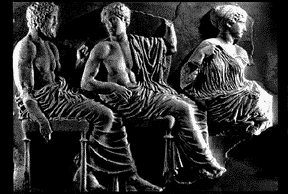
The concept of numen continued to exist and it was related to any manifestation of the divine. For the Romans, everything in Nature is thought to be inhabited by numina, which explains the big number of deities in the Roman pantheon, as will be shown. Numina manifest the divine will by means of natural phenomena, which the pious Roman constantly seeks to interpret. That's why great attention is paid to omens and portents in every aspect of Roman daily life.
A groups of twelve Gods called Dii Consentes is especially honored by the Romans: Iuppiter, Iuno, Minerva, Vesta, Ceres, Diana, Venus, Mars, Mercurius, Neptunus, Volcanus, and Apollo. These are the ones listed by the Poet Ennius about the 3rd Century, B.C.E.. Their gilt statues stood in the Forum, later apparently in the Porticus Deorum Consentium. As there were six male and six female, they may well have been the twelve worshipped at the lectisternium of 217 BC.
A lectisternium is a banquet of the gods, where the statues of the gods were put upon cushions, and where these statues were offered meals. The number 12 was taken from the Etruscans, which also worshipped a main pantheon of 12 Gods. Nevertheless, the Dii Consentes were not identified with Etruscan deities but rather with the Greek Olympian Gods (though the original character of the Roman Gods was different from the Greek, having no myths traditionally associated). The twelve Dii Consentes are lead by the first three, which form the Capitoline Triad. These are the three cornerstones of Roman religion, whose rites were conducted in the Capitoleum Vetus on the Capitoline Hill.
But what better characterizes the traditional Roman Religion is the household or family cult of the Dii Familiaris. In this cult, the Lar Familiaris (guardian spirit - Genius - of the family), the Lares Loci (guardian spirits of the place where the house is built), the Genius of the paterfamilias (House-Father), the Dii Penates (patron gods of the storeroom), the Dii Manes (spirits of the deceased) and a multitude of other domestic deities are daily worshipped by the members of the family. The household cult is so important that it even serves as the model for several practices of the state cult (e.g. there were the Lar Praestites, Penates Publici, etc.. Even during the Empire, the Imperial cult came to be based on the household cult, now interpreted as the cult of the Genius of the Emperor, paterfamilias of the family of all the Romans).
Other important Gods are Ianus, Saturnus, Quirinus, Volturnus, Pales, Furrina, Flora, Carmenta, Pomona, Portunus, Fontanus. There is also a group of mysterious deities formed by native tutelary deities, river Gods or deified heroes from Latium which are collectively called Dii Indigites (e.g. deified Aeneas, Faunus, Sol Indiges, Iuppiter Indiges, Numicus). A multitude of other deities is also traditionally worshipped, which includes tutelary deities (e.g. Roma, Tiberinus), native Latin deities (e.g. Bellus, Bellona, Liber, Libera), abstract deities such as Fortuna (Fate), Concordia (Concord), Pax (Peace), Iustitia (Justice), etc..
Pre-Roman native italian deities mainly adopted from the Sabines and Etruscans are also worshipped: Nerio (Sabine deity and the consort of Mars), Dius Fidius (Sabine as well), etc. In fact, Quirinus and Vertumnus were also adopted respectively from the Sabines and Etruscans. The Dii Inferi, Gods of the Underworld (Inferus) are Dis/Orcus and Proserpina, equated to the Greek Gods Hades/Plouton (Pluto in Latin) and Persephone. These Gods symbolize the creative power of the Earth which provide human beings the means for subsistence (Dis = wealth = Plouton in greek). The Inferus is also traditionally regarded as the home for the spirits of the dead, though the concept of afterlife was quite varied.
The pious spirit of the Romans consists of a constant wish to bring the favor of the divine upon him, the family and the state. As such, the Roman is naturally willing to pay the deserved homage and sacrifice to foreign deities, specially if he is in their land. In order to achieve victory in war, the Romans often asked the favor of the Gods of their enemies, paying them sacrifices even greater than those offered by their own people. This spirit joined by the affluence of foreigners which resulted either from trade or conquest, brought new cults to Rome. These were as expected democratically adopted by permitting the priests of these Gods to establish temples in Rome. Among the foreign deities, the Dii Novensiles, are Apollo, Ceres (these were adopted as early as to allow them to become part of the Dii Consentes), Bacchus/Dionysus, Sol Invictus Elagabalus, Isis, Serapis, Cybele, Attis, Mithras and many others.
Roman and Greek God Comparisons
| Roman |
Greek |
| Apollo |
Apollo |
| Bacchus |
Dionysus |
| Ceres |
Demeter |
| Coelus |
Uranus |
| Cupid |
Eros |
| Cybele |
Rhea |
| Diana |
Artemis |
| Hercules |
Heracles |
| Juno |
Hera |
| Jupiter |
Zeus |
| Latona |
Leto |
| Mars |
Ares |
| Mercury |
Hermes |
| Minerva |
Athena |
| Neptune |
Poseidon |
| Pluto |
Hades |
| Proserpina |
Persephone |
| Saturn |
Cronus |
| Ulysses |
Odysseus |
| Venus |
Aphrodite |
| Vesta |
Hestia |
| Vulcan |
Hephaestus |
MAJOR DIETIES
APOLLO
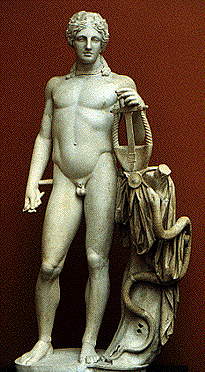
Apollo was the son of Jupiter and Latona. His twin sister was Diana. He was the god of music, playing a golden lyre. The Archer, far shooting with a silver bow. The god of healing who taught man medicine. The god of light. The god of truth, who can not speak a lie.
One of Apollo's more important daily tasks was to harness his chariot with four horses an drive the Sun across the sky.
His tree was the laurel. The crow his bird. The dolphin his animal.
CERES
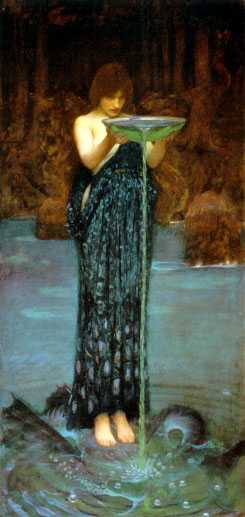
Ceres daughter of Saturn and Rhea. Wife-sister of Jupiter and mother of Prosperpina. Ceres is the goddess of grain, growing plants and the love that a mother bears for her child. Personified and celebrated by women in secret rituals at the festival of Ambarvalia, held during the month of May.
DIANA
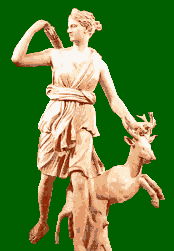
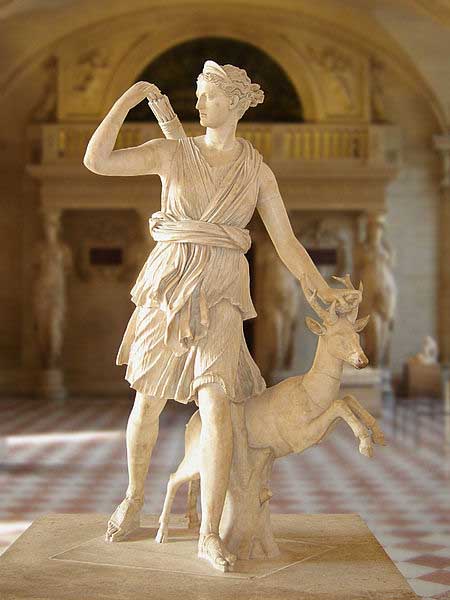
Diana is the mother of wild animals and forests, and a moon goddess. Oak groves are especially sacred to her. She is praised for her strength, athletic grace, beauty and her hunting skills. With two other deities she made up a trinity: Egeria the water nymph, her servant and assistant midwife; and Virbius, the woodland god.
JUNO

Juno was the Queen of the Gods and Jupiter's wife. The Goddess of heaven and of the moon Juno symbolized the matronly qualities desired for in Roman women. She was the protector of woman during childbirth, rearing, and their preparation for marriage. It was said that she was present and watching during all marriage ceremonies.
Juno protected the City of Rome when the Gauls attacked. Before the attack the sacred geese in the temple of Juno alerted the Romans of the pending danger. This warning gave the Romans the opportunity to attack and defeat the Gauls and save their city.
In addition to geese the peacock was also a sacred symbol of Juno.
A daughter of Jupiter, Minerva, is born through magic. It was said she came directly from the head of Jupiter , not needing the aid of Juno for her birth. This turn of events caused Juno to feel jealousy. Angry, Juno seeks a magic flower that is suppose to allow fertilization without a man. Finding the rare flower juno uses it to become pregnant and gives birth to Mars.
Juno is the Roman supreme goddess and is married to the ruling god, Jupiter. She is believed to watch and protect all women. Every year, on the first of March, women hold a festival in honor of Juno called the Matronalia. To this day, many people consider the month of June, which is named after the goddess who is the patroness of marriage, to be the most favorable time to marry. The peacock is sacred to Juno.
JUPITER
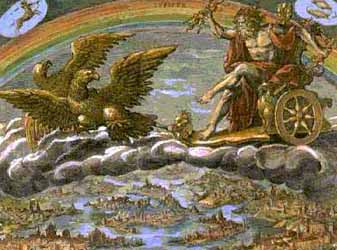
Jupiter the supreme ruling god. Considered god of the sky and weather, and guardian of all property, oaths and treaties.
Jupiter is the king of the Roman gods. He has had many different names because he was adapted to fit the Roman's current needs. When the Roman Republic first appeared, he was Jupiter Lucetius. Jupiter Lucetius was the god of sun and moonlight. He also went by the names of Jupiter Elicius (god of wind, rain, storms, thunder, and lightning), Jupiter Dapalis (god of sowing), Jupiter Liber (god of creative forces), and Jupiter Terminus(god of boundary stones of fields). These incarnations of the god were caused by the fact that the early republic was very agricultural.
As the Roman Republic turned into the Roman Empire, Jupiter became known as a militant god. He assumed names such as Jupitor Strator, Jupitor Feretrius, and Jupiter Victor(warrior gods), Jupiter Optimus Maximus(great god of the empire), Jupiter Conservator Orbis(protector of the empire), and Jupitor Conservator Ator Augustorum(protector of the emperor). His main temple, Capitolum Vetus, was located on the Capitoline Hill. Jupiter is often depicted as a bearded older man, probably to show that he is wise.
His sacred animal is the eagle. The planet that bears the name Jupiter, does so because it is the largest and most majestic planet.
MARS
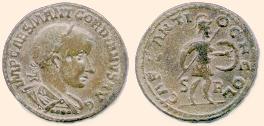
Mars was the consort of Rhea Sylvia and father of Romulus and Remus, and therefore the father of the Roman people. He was the Roman god of war, the beginning and ending of battles.
Mars was the god of young men and their activities, primarily war. He was celebrated in March and October. His festival was called the Quinquartus. It was five days of celebration during the vernal equinox. Mars was the son of Juno and the father of the twins Romulus and Remus, the founders of Rome. The planet Mars was named after the god because its red color looked like blood.
MERCURY
Mercury was the Roman god of commerce. Merchants prayed to him in order to get good business. Mercury was the son of Jupiter and Maia. He was also the messenger of the gods. He used the characteristic winged sandals to help him get around faster. He was first worshipped in 495 B.C. when a temple was dedicated to him near Circus Maximus. He was often depicted with a money bag to indicate his work as god of commerce. He was also said to have had a caduceus and a winged helmet. His name comes from the Latin word "mercari". Mercari means having to do with deal or trade. His sacred animal was the chicken and he is sometimes depicted with it. His festival is celebrated on May 15.
MINERVA
Minerva the daughter of Jupiter and Juno. Considered to be the virgin goddess of warriors, poetry, medicine, wisdom, commerce, crafts, and inventor of music. Ovid called her the "goddess of a thousand works." The Romans celebrated her worship from March 19 to 23 during the Quinquatrus, the artisans' holiday.
Minerva, Goddess of wisdom and learning, meditation, inventiveness, accomplishments, the arts, spinning and weaving, and commerce. Minerva was identified with Pallas Athene, bestower of victory, when Pompey the Great built her temple with the proceeds from his eastern campaigns. Minerva and Mars are honored Quinquatras, five days at the Spring equinox. But Minerva has many aspects, attributes, names and epithets.
NEPTUNE
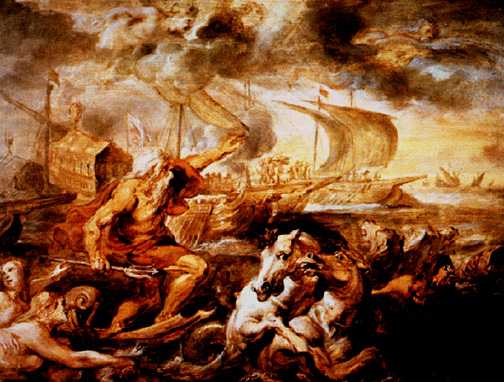
Neptune is the god of the sea. He is the son of Saturn, whom he helped to overthrow, and the brother of Jupiter and Pluto. His festival is celebrated on July 23. God of all the fresh water (from rivers, springs, etc.) and of equestrian accomplishments. Equated to the Greek Poseidon, He is also the God of the sea. He had temples in the Circus Flaminius and later on the Campus Martius. His festival, the Neptunalia is celebrated on July 23. But Neptunus has many aspects, attributes, names and epithets.
PLUTO
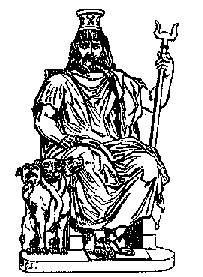
Pluto is the Roman god of the underworld. He chose this realm after he and his two brothers overthrew their father and divided up the world. He was first thought to be a fierce and cruel god who didn't listen to prayers and didn't care about sacrifices. The later cults stressed the milder aspects of the god. He was later believed to be the one that puts precious metals and other treasures in the earth.
PROSERPINA
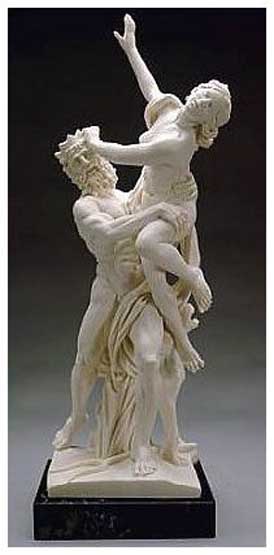
Proserpina is the counterpart of the Greek goddess, Persephone. She was kidnapped by Pluto and taken to his underworld and made queen of the dead.
SATURN
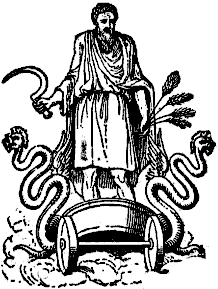
Saturn was Jupiter's father. He was king of the gods and sky before Jupiter and his brothers, Neptune and Pluto, decided to fight the power of their father and overthrow him. They divided up the world. Jupiter ruled the Earth and the sky, Pluto ruled the underworld, and Neptune ruled the sea.
After he was dethroned, he fled to Italy and ruled there during what is known as the Golden Age, a time of peace and prosperity. The Golden Age is restored every year for 7 days starting December 17, during his festival, known as Saturnalia. During this time everyone is happy and treated well. Saturn had other children besides Jupiter, Pluto, and Neptune. His other children were Juno(goddess of marriage) and Ceres(goddess of the grain).
Saturn was an ancient Italian deity. It was attempted to identify him with the Grecian god Cronos, and fabled that after his dethronement by Jupiter he fled to Italy, where he reigned during what was called the Golden Age. In memory of his beneficent dominion, the feast of Saturnalia was held every year in the winter season. Then all public business was suspended, declarations of war and criminal executions were postponed, friends made presents to one another, and the slaves were indulged with great liberties. A feast was given them at which they sat at table, while their masters served them, to show the natural equality of men, and that all things belonged equally to all, in the reign of Saturn. Faunus,* the grandson of Saturn, was worshipped as the god of fields and shepherds, and also as a prophetic god. His name in the plural, Fauns, expressed a class of gamesome deities, like the Satyrs of the Greeks.
VENUS
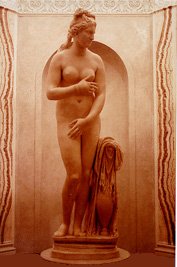
Venus is the Roman goddess of love and sexual desire. She was worshipped under many names in imperial times such as Venus Genetrix(mother of Aeneas), Venus Felix(bringer of good fortune), Venus Victrix(bringer of victory), and Venus Verticordia(protector of feminine chastity). She was married to the god Vulcan, but often cheated on him. She committed adultery with many men, among them Mars, Adonis(a shepherd), Anchises (father of Aeneas).
Cupid was Venus's son and the god of love.
Venus daughter of Jupiter and Dione, although sometimes portrayed as being created by Uranus from the foam of the sea at the moment of his death. As the goddess of love, she is the "queen of pleasure" and mother of the Roman people. She was married to Vulcan, the lame god of the forge, and mother of Cupid, Hymen, Priapus and Aeneas. She is also associated with her lover, Mars the god of war. Considered a nature goddess, associated with the arrival of spring. Venus is the bringer of joy to gods and humans.
VULCAN
Vulcan the son of Jupiter and Juno. Husband of Maia and Venus. God of fire and volcanoes, and the manufacturer of art, arms and armor for gods and heroes
MINOR DIETIES
JANAS
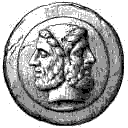
Janus was the porter of heaven. He opens the year, the first month being named after him. He is the guardian deity of gates, on which account he is commonly represented with two heads, because every door looks two ways. His temples at Rome were numerous. In war time the gates of the principal one were always open. In peace they were closed; but they were shut only once between the reign of Numa and that of Augustus.
VESTA
On of the most popular and mysterious goddesses of the Roman pantheon. Vesta is the goddess of the hearth, equated with the Greek Hestia. There is not much known of her origin, except that she was at first only worshipped in Roman homes, a personal cult. Her cult eventually evolved to a state cult.
One myth tells that her service was set up by king Numa Pompilius (715-673 BC). In her temple on the Palatine Hill, the sacred fire of the Roman state burned, which was maintained by the Vestal Virgins. At the start of the new Roman year, March 1, the fire was renewed. The sacred fire burned until 394 AD. Vesta's temple was situated on the Forum Romanum and was built in the third century BC. None of her temples, however, contained a statue of the goddess. Her festival is the Vestalia, which was observed from June 7 - 15. On the first day of this festival, the 'penus Vestae', the inner sanctum of the Vesta temple which was kept closed the entire year, was opened for women who came to bring offerings bare-footed. The temple was ritually cleansed on the last day.
The ass is Vesta's sacred animal, whose braying supposedly kept the lascivious Priapus away. Vesta is portrayed as a stern woman, wearing a long dress and with her head covered. Her right hand rests against her side and in her left hand she holds a scepter.
|

